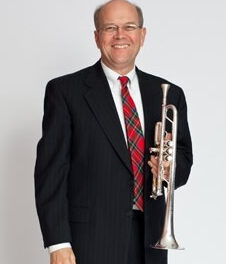George Troxler, Elon’s arts “Impresario,” timed his opening remarks on March 30 in order to delay the start of the concert and avoid a long, noisy freight train passing on the all-too-nearby tracks. Perhaps laggards from the recent end of spring break accounted for a smaller than usual audience in Whitley Auditorium. The occasion was the return of a trio of musicians associated with the Carmel Bach Festival. They were an instant hit when they appeared in the same venue two years ago. The program was more diverse on this occasion, consisting of five baroque pieces spiked by two 20th-century works and three arrangements of well-known American hymns. Rosa Lamoreaux, lyric soprano, Wolfgang Basch, piccolo trumpet, and John Butt, organ, were heard as a trio, in duos, and as soloists. Butt, currently Chair of the Music Department at Glasgow University (Scotland), is known for his eight solo recordings on the Harmonia Mundi label and as the editor of The Cambridge Companion to Bach . Basch, Principal Trumpet of the Museums Orchestra (Opera Orchestra), Frankfurt-am-Main, Germany, is a much-sought-after soloist and favorite with many music festivals. Recordings featuring him can be found on labels such as RCA/BMG, Decca, and Koch. Lamoreaux is very popular with Bach festivals in both the USA and Europe.
Butt chose two 20th-century French works to display Elon’s gorgeous Alyse Smith Cooper organ (built by Casavant Frères, Ltd.) in a full workout. In remarks before “Joie et Clarté” from Les Corps Glorieux by Oliver Messaien, the organist quipped that, although the composer hated jazz, there are “certainly some very un church-like sounds” in the piece. From its highly chromatic opening fanfare, it was fascinating to watch Butt in action, moving rapidly across three keyboards as well as the pedals. He used a wide dynamic range, from the quietest “pp” to a soaring forte, and a plethora of instrumental colors from varied registrations. It was interesting to hear the chromatic spin Jean Langlais added to three well-known German tunes -“Eine feste Burg ist unser Gott,” “Vater unser im Himmelreich,” and “Lobe den Herrn.” These had the benefit of Basch’s trumpet sharing the chorales with the organ in a series of back-and-forth exchanges.
Lyric soprano Lamoreaux has very precise diction, a voice evenly supported throughout its range, and an impeccable sense of style. She was joined by both colleagues in an opening work by Alessandro Scarlatti (1660-1725), a work by Tarquinio Merula (1595-1665) just before intermission and an extended Cantata by Alessandro Melani (1639-1703) that ended the program. Scarlatti’s Sinfonia, Recitative and Aria from Il giardino di Amore proved delightful. The Sinfonia was a typical fast-slow-fast movement in which the organ opened with trills followed by Basch’s piccolo trumpet in its highest register. The sheer perfection of his playing was marred by a brief “clinker” in the opening bar, his only noticeable flaw in either this concert or the one in 2002. Butt made a virtual chamber orchestra out of the organ, and he and Basch joined in wonderful unisons. Lamoreaux’s crisp and clear recitative was a model for all to emulate. In the aria, she and the trumpet traded lines, now in contrast, now together in exactly matched phrasing. More than once I was led to wonder if the trumpet was being used vocally or the voice was being treated instrumentally. In truth, both were models of bel canto style, so admired by composers from the Baroque through Wagner. All these virtues held true for the concluding “All’ armi pensieri” by Melani. This consists of four recitatives and four arias. Most memorable were the trills Lamoreaux executed to perfection. The “Gaudeamus omnes” of Merula was originally for violin but has been taken up by trumpet players. The organ was largely used as continuo, backing richly ornamented lines for Basch and Lamoreaux.
A sort of suite for trumpet and organ was made from Heldenmusik , by George Philipp Telemann (1681-1767). “La Majesté” is conventional while “La Gaillardise” has an attractive theme taken up by each in turn. “La Grace” is a slow movement with an extended melody taken up by the organ alone, “La Vigilance” is fast, opening as a duo and featuring extended organ solos, and “La Vaillance” brings the sequence to a fast and lively ending.
Butt’s mastery of J.S. Bach was sampled by the German’s arrangement of Vivaldi’s Concerto Grosso in D Minor, Op. 3/11 (RV.565). The organist pointed out that Bach was writing for the organ “in a new way, bringing the rhythmic verve of string instruments to the keyboard.” It was interesting to hear how Mediterranean sensibility had become a kaleidoscope of the North German aesthetic. The dynamics were richly varied, and there was a memorable solo for the organ’s treble.












